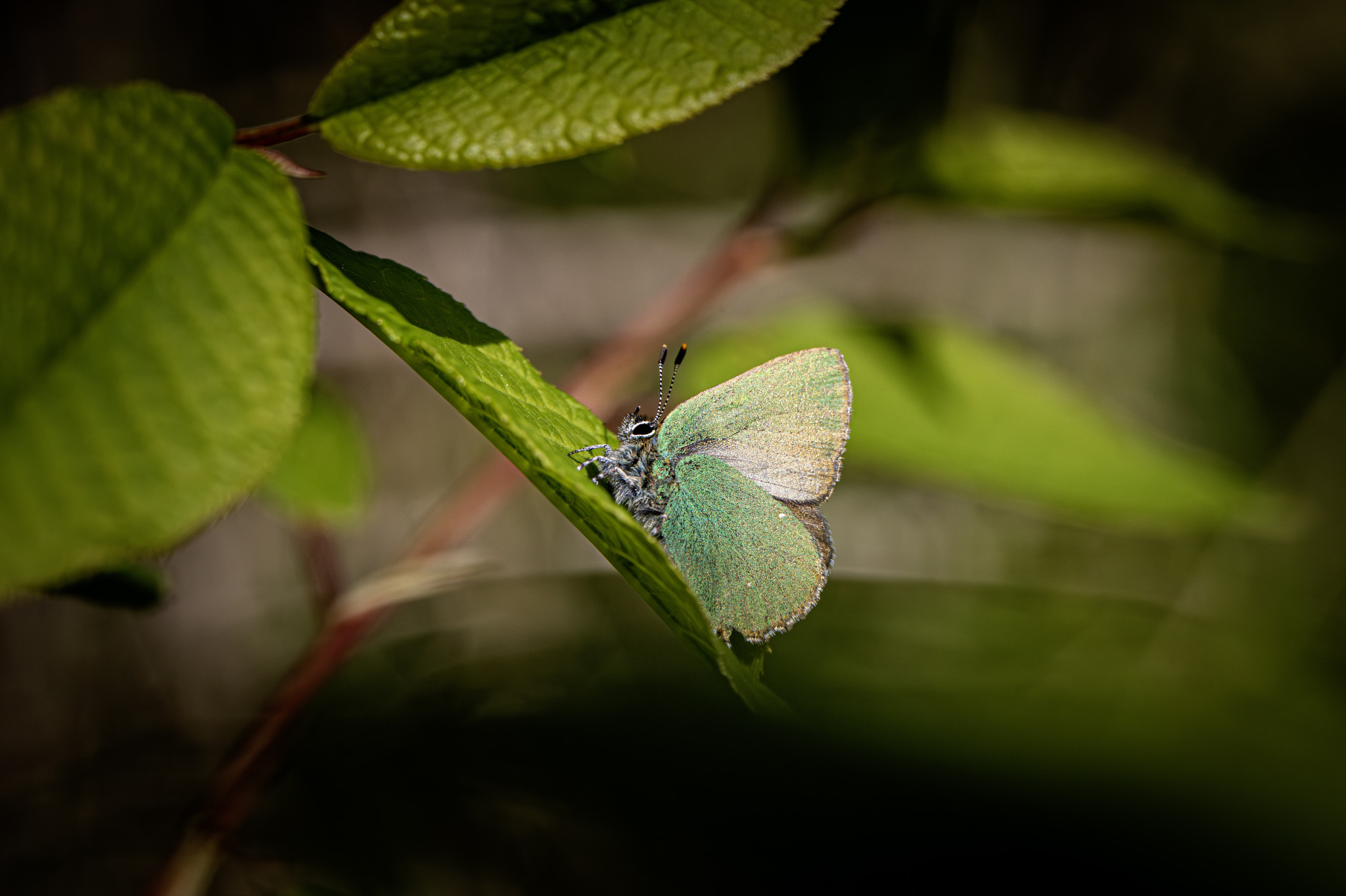The Green Hairstreak (Callophrys rubi) is a small and striking butterfly known for its vibrant green coloration. Here’s a detailed overview of this fascinating species:
Description
- Appearance: The Green Hairstreak is characterized by its bright green underwings, which provide excellent camouflage against foliage. The upper side of the wings is brown, but this is rarely seen as the butterfly usually rests with its wings closed.
- Size: This butterfly has a wingspan of about 28 to 34 millimeters.
Habitat
- Distribution: Callophrys rubi is found throughout Europe, including the British Isles, as well as in parts of Asia and North Africa. It inhabits a variety of habitats, including heathlands, grasslands, scrublands, and woodland clearings.
- Preferred Environment: They are often found in sunny, sheltered areas where there is an abundance of their larval food plants.
Behavior and Ecology
- Flight Period: The Green Hairstreak typically has one generation per year, with adults emerging from April to June, depending on the location.
- Diet:
- Larvae: The caterpillars feed on a wide range of plants, including bilberry (Vaccinium myrtillus), gorse (Ulex spp.), bird’s-foot trefoil (Lotus corniculatus), and broom (Cytisus scoparius).
- Adults: Adult butterflies feed on nectar from various flowers, including gorse, dandelions, and buttercups.
- Reproduction: Females lay their eggs singly on the flower buds or young leaves of the host plants. The larvae are green with white lines, blending well with the foliage.
Conservation
- Threats: The main threats to the Green Hairstreak include habitat loss due to agricultural intensification, urban development, and changes in land use practices. Climate change also poses a potential threat by altering the availability of suitable habitats.
- Conservation Efforts: Conservation efforts focus on maintaining and restoring suitable habitats. This includes managing heathlands and grasslands to ensure the presence of larval food plants and providing a diversity of nectar sources for adults.
Observing Green Hairstreaks
- Best Times: The best time to observe Green Hairstreaks is during their flight period from late spring to early summer.
- Watching Tips: Look for these butterflies in sunny, sheltered areas where their host plants are present. They often perch on shrubs and low vegetation, and their green coloration makes them blend in with the leaves.
Interesting Facts
- Camouflage: The green coloration of the underwings provides excellent camouflage, making the butterfly difficult to spot when it is at rest.
- Territorial Behavior: Males are territorial and can often be seen perching on prominent spots, chasing away intruders.
- Lifespan: As with most butterflies, the Green Hairstreak has a short adult lifespan, typically around a few weeks, during which time they must mate and lay eggs to ensure the next generation.
Summary
The Green Hairstreak (Callophrys rubi) is a beautiful and ecologically important butterfly that brings vibrant color to the landscapes it inhabits. Protecting its habitats and understanding its life cycle are crucial for ensuring its continued presence in our ecosystems. Whether you are a butterfly enthusiast or a casual observer, spotting the elusive Green Hairstreak is always a rewarding experience.
Estonia is home to a variety of butterflies, thanks to its diverse habitats ranging from forests and meadows to wetlands and coastal areas. Some notable butterflies found in Estonia include:
Common Butterflies:
- Peacock Butterfly (Inachis io): Recognizable by its striking eyespots on the wings, this butterfly is commonly seen in gardens and woodlands during late summer and early autumn.
- Painted Lady (Vanessa cardui): Known for its orange and black-patterned wings, this migratory butterfly is often spotted in meadows and gardens.
- Small Tortoiseshell (Aglais urticae): Featuring bright orange and black patterns with blue spots, it frequents gardens, meadows, and open woodlands.
- Comma Butterfly (Polygonia c-album): Named for the comma-shaped mark on its hind wings, it is found in woods and gardens, especially in late summer and autumn.
- Cabbage White (Pieris rapae): This common butterfly has white wings with black spots and is often seen in gardens, particularly where cabbage and other Brassicaceae plants are growing.
Forest and Woodland Butterflies:
- Purple Emperor (Apatura iris): This large butterfly has a striking purple sheen on its wings and is found in mature broadleaved forests.
- Silver-washed Fritillary (Argynnis paphia): With its orange wings and silver underside, it frequents woodland clearings and sunny areas.
- Brimstone (Gonepteryx rhamni): Recognizable by its bright yellow wings, this butterfly can be found in hedgerows and woodlands.
Meadow and Grassland Butterflies:
- Meadow Brown (Maniola jurtina): This butterfly is commonly seen in grassy meadows and fields, with its brown wings featuring orange spots.
- Common Blue (Polyommatus icarus): A small butterfly with vibrant blue wings, often found in meadows and grassy areas.
- Skipper Butterflies (Hesperiidae): Various species, such as the Large Skipper (Ochlodes sylvanus), are present in grasslands and meadows.
Wetland Butterflies:
- Swallowtail (Papilio machaon): The largest butterfly in Europe, it is occasionally found in wetland areas where its larval food plants are present.
- Marsh Fritillary (Euphydryas aurinia): A butterfly that prefers damp meadows and marshes, it has distinctive orange and black markings.
Estonia’s butterfly fauna is diverse, reflecting the country’s varied habitats. The changing seasons also bring different species into view, making butterfly watching a rewarding activity throughout the year.
Views: 1269
Subscribe to the newsletter:
